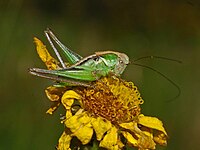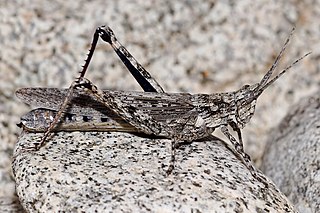
Acrididae, commonly called short-horned grasshoppers, are the predominant family of grasshoppers, comprising some 10,000 of the 11,000 species of the entire suborder Caelifera. The Acrididae are best known because all locusts are of the Acrididae. The subfamily Oedipodinae is sometimes classified as a distinct family Oedipodidae in the superfamily Acridoidea. Acrididae grasshoppers are characterized by relatively short and stout antennae, and tympana on the side of the first abdominal segment.
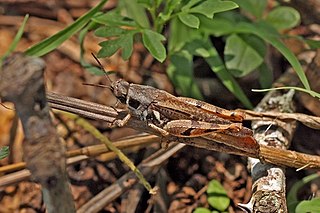
The subfamily Catantopinae is a group of insects classified under family Acrididae. Genera such as Macrotona may sometimes called "spur-throated grasshoppers", but that name is also used for grasshoppers from other subfamilies, including the genus Melanoplus from the Melanoplinae.

Bandwings, or band-winged grasshoppers, are the subfamily Oedipodinae of grasshoppers classified under the family Acrididae. They have a worldwide distribution and were originally elevated to full family status as the Oedipodidae. Many species primarily inhabit xeric weedy fields, and some are considered to be important locusts:

The grasshopper subfamily Acridinae, sometimes called silent slant-faced grasshoppers, belong of the large family Acrididae in the Orthoptera: Caelifera.
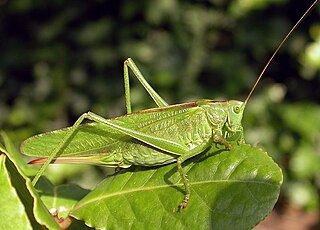
The Tettigoniinae are a subfamily of bush crickets or katydids, which contains hundreds of species in about twelve tribes.

Isophya is a genus of bush crickets, in the tribe Barbitistini, found from mainland Europe to western Asia.

Stenobothrus is a genus of grasshoppers found in Asia, Europe, and North Africa.

The Phaneropterinae, the sickle-bearing bush crickets or leaf katydids, are a subfamily of insects within the family Tettigoniidae. Nearly 2,060 species in 85 genera throughout the world are known. They are also known as false katydids or round-headed katydids.
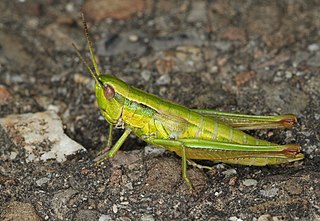
Gomphocerinae, sometimes called "slant-faced grasshoppers", are a subfamily of grasshoppers found on every continent but Antarctica and Australia.
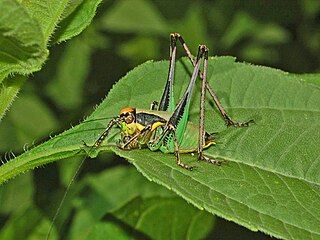
Eupholidoptera is a genus of bush crickets belonging to the subfamily Tettigoniinae.

Leptophyes is a genus of bush-crickets found in Africa, Asia, and Europe. The genus was erected by Franz Xaver Fieber in 1853.

Poecilimon is a genus of bush crickets in the subfamily Phaneropterinae and tribe Barbitistini. Species can be found in: central and Southeast Europe, the south of the European part of the former USSR, Asia Minor, Syria, Palestine, the Caucasus, Persia and extends in Central Asia to the Altai mountains.
Dericorys is the type genus of grasshoppers of the family Dericorythidae. Species have been recorded from Africa, the Iberian peninsula, Atlantic islands and western Asia.

Ochrilidia is a genus of grasshoppers in the subfamily Gomphocerinae and typical of the tribe Ochrilidiini; it was erected by Carl Stål in 1873. Species have been recorded from Africa, the Middle East through to India and certain Mediterranean islands in Europe.
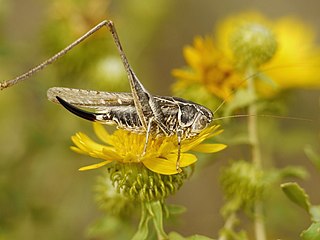
Montana is a genus of bush crickets in the tribe Platycleidini, erected by F.E. Zeuner in 1941. The type species, M. montana has been called the "Steppe Bush-Cricket". Some authorities previously placed this as a subgenus of Platycleis, but it is now considered a separate genus, as part of the genus group Platycleis. Species can be found in the northern Palaearctic realm from mainland western Europe through to Siberia.

Incertana is a genus of bush crickets in the tribe Platycleidini, erected by erected by F. E. Zeuner in 1941. Species have been recorded from: North Africa, southern Europe, the Middle East and the Himalayas. Placed in genus group Platycleis, literature on the type species and others often refers to that genus.

Anadrymadusa is a genus of bush crickets in the tribe Drymadusini, erected by Tevfik Karabağ in 1961. Species have been recorded from Greece and Turkey through to Afghanistan.

Zeuneriana is a genus of Palaearctic bush crickets in the tribe Platycleidini and now placed in the genus group Metrioptera F. E. Zeuner: after whom it was named by W. Ramme in 1951. The recorded distribution of species is: mainland Europe, from Spain and France through to the Balkans and Romania.




